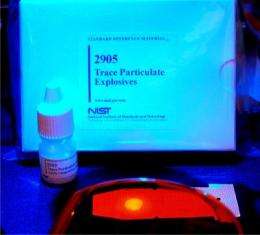New NIST trace explosives standard slated for homeland security duty

Security personnel need to be able to find explosive materials and persons who have been in contact with them. To aid such searches, the National Institute of Standards and Technology, with support from the Department of Homeland Security, has developed a new certified reference material, Standard Reference Material (SRM) 2905, Trace Particulate Explosives. Compatible with field and laboratory assay methods, the SRM will be helpful in calibrating, testing and developing standard best operating procedures for trace-explosives detectors.
Most air travelers have probably had some experience with prototype walkthrough portal or tabletop-type trace explosive detectors. Customs inspectors use the machines to check international cargo shipments, and firefighters and police officers use them to evaluate suspicious packages.
The goal of these detectors is to effectively collect residue particles that result from handling materials that might be used to fabricate a bomb and then evaluate the explosives content. For example, when operating the tabletop device, security personnel use a piece of material to swab packages and bags for explosive residues. The security officer then places the swab in a tabletop device that heats the material, separating any chemical residues that may have been absorbed.
Like other sensitive instruments, these machines need well-defined calibration standards to ensure that they are working properly. According to NIST chemist William MacCrehan, the calibration materials that the vendors of these machines provide are typically of unknown quality.
"These detectors need to be reliable and precise enough to detect particles that weigh as little as a few billionths of a gram," says MacCrehan. "We created this SRM to provide manufacturers and operators with high quality, independently generated and validated reference test materials to enable better designs and reduce the number of false positives and negatives."
SRM 2905 consists of four different test substances designed to simulate trace residues of C-4 plastic explosives and TNT. The substances themselves consist of inert solid particles about 20 to 30 microns in diameter. The particles have been coated with explosive materials and a florescent tag, which enables the material to be seen using specially filtered optics or glasses. Although the particles are coated with explosive material, MacCrehan says they are incapable of exploding on their own and are completely safe to handle.
This release is part of a larger, ongoing project to develop other wet and dry materials that simulate SEMTEX, gunpowder and peroxide-type explosives. According to MacCrehan, efforts also are underway to develop reference materials to help train bomb-sniffing dogs.
Source: National Institute of Standards and Technology (news : web)
















